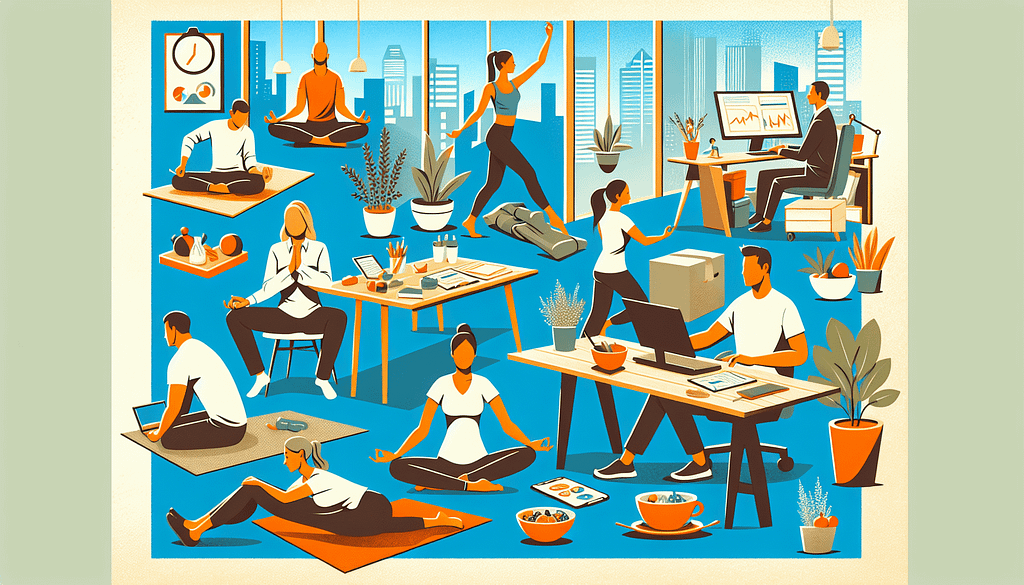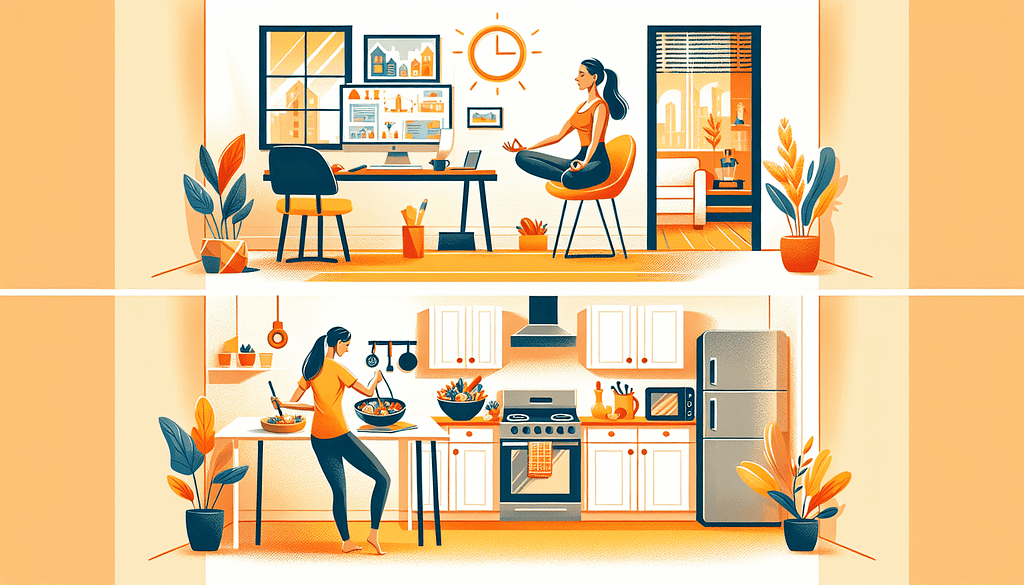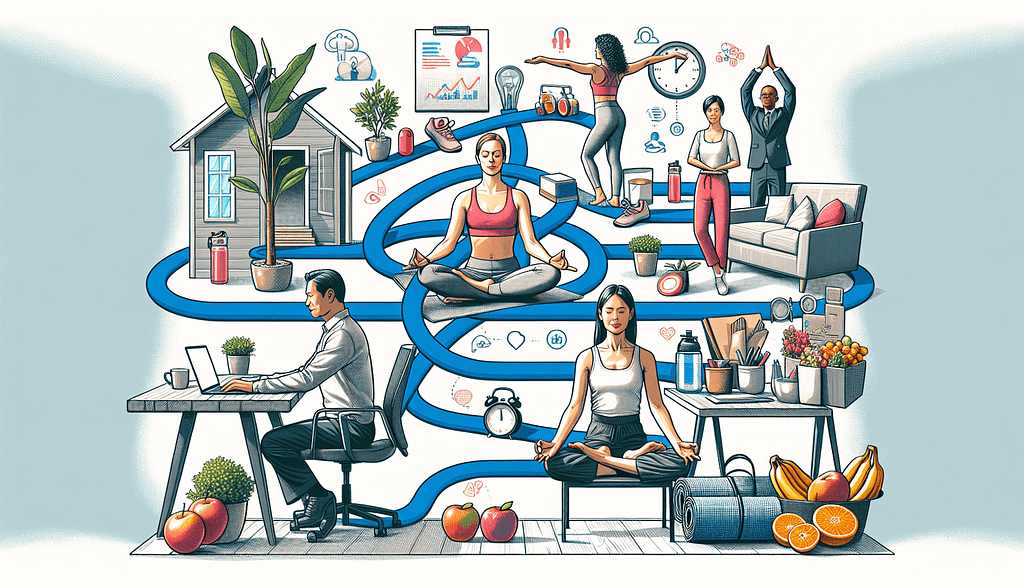Are you wondering how to seamlessly incorporate wellness practices into both your work and home life? Look no further! This article explores practical strategies and tips on integrating various wellness practices, such as mindfulness, physical activity, and healthy eating, into your daily routine. Discover how you can achieve a state of holistic well-being by establishing a harmonious balance between your professional and personal life. With these valuable insights, you will be equipped to make positive lifestyle changes that will enhance your overall health and happiness. Let’s explore the world of wellness together!
Create a Morning Routine
A morning routine is an essential part of starting your day on the right foot. By setting a consistent wake-up time, you establish a sense of structure and allow yourself ample time to prepare for the day ahead. Waking up at the same time every morning helps regulate your body’s internal clock, promoting better sleep quality and overall well-being.
Incorporating activities that promote wellness into your morning routine can significantly improve your physical and mental health. Dedicate time for exercise, whether it’s a brisk walk, yoga session, or a quick workout. Physical activity increases blood flow, boosts energy levels, and promotes a positive mood. Additionally, consider practicing mindfulness or meditation to calm your mind, reduce stress, and enhance focus for the day ahead.
Allocate a few minutes for self-reflection and goal setting each morning. Take some time to journal your thoughts, set intentions for the day, or prioritize tasks. This practice allows you to start the day with clarity, purpose, and a sense of direction.
Establish Healthy Eating Habits
Nutrition plays a vital role in maintaining wellness throughout the day. By preparing nutritious meals at home, you have control over the ingredients used and can ensure a balanced diet. Stock your kitchen with wholesome foods like fruits, vegetables, lean proteins, whole grains, and healthy fats. Plan your meals ahead of time to avoid impulsively reaching for unhealthy options.
When going to work, make a habit of packing healthy snacks to avoid mindless eating or succumbing to unhealthy vending machine options. Opt for fruits, nuts, yogurt, or homemade granola bars. By having nutritious snacks readily available, you can fuel your body with sustenance and maintain energy levels throughout the day.
Practicing mindful eating is also essential to foster a healthier relationship with food. Slow down and pay attention to your food while eating, savoring each bite and allowing yourself to fully enjoy the flavors and textures. Eating mindfully promotes better digestion and can help prevent overeating.
Stay Active Throughout the Day
Incorporating movement breaks into your workday is crucial in combating the negative effects of sedentary behavior. Take regular breaks to stretch, walk around, or engage in light physical activity. This simple practice can boost circulation, relieve muscle tension, and improve your overall mood and productivity.
Choosing to take the stairs instead of the elevator is another way to incorporate physical activity into your daily routine. Climbing stairs is an excellent cardiovascular exercise that helps strengthen your leg muscles and burns calories. Plus, it saves time compared to waiting for an elevator!
Finding time for physical activities during your leisure time is equally important. Engage in activities you enjoy, such as dancing, swimming, hiking, or playing a sport. By making exercise a fun and enjoyable part of your life, you’ll be more motivated to stay active and reap the many benefits it offers.
Practice Stress Management Techniques
Stress is a common part of life, but managing it effectively is crucial for overall wellness. Deep breathing exercises are a simple yet powerful technique to reduce stress. Practice taking slow, deep breaths, inhaling through your nose and exhaling through your mouth. Deep breathing triggers the relaxation response in your body, calming your nervous system and promoting a sense of calm and balance.
Meditation is another effective stress management tool. Find a quiet and comfortable space, close your eyes, and focus on your breath or a specific mantra. Regular meditation practice helps cultivate mindfulness, reduces anxiety, and enhances overall well-being. Start with just a few minutes a day and gradually increase the duration as you become more comfortable.
It’s also essential to find healthy outlets for stress in your life. Engaging in hobbies or activities you enjoy can help divert your attention from stressors and contribute to a sense of fulfillment. Make time for socializing with friends and loved ones, as social support is crucial in managing stress and boosting overall happiness.
Create a Supportive Work Environment
A positive and supportive work environment is vital for both your mental and physical well-being. Promote open communication and collaboration with your colleagues. Encourage sharing ideas, concerns, and feedback to foster a sense of inclusivity and teamwork. Having a supportive network at work can help alleviate stress.
Encouraging breaks and time off is essential to prevent burnout and maintain productivity. Encourage your team members to take regular breaks throughout the day to recharge and refocus. Additionally, advocate for the importance of utilizing vacation time to disconnect from work and prioritize self-care.
Implement wellness programs or initiatives in your workplace. This can include organizing workshops on stress management, providing healthy snacks or meals, offering fitness classes, or creating designated relaxation spaces. These initiatives can improve employee morale, increase productivity, and create a more positive work environment.
Set Boundaries between Work and Home
In today’s digital age, it’s become increasingly challenging to separate work life from personal life. However, setting clear boundaries between the two is crucial for maintaining a healthy work-life balance.
Establish a dedicated workspace at home, ideally a separate room or area designated exclusively for work. Having a designated space helps create a psychological boundary between work and relaxation. It also signals to your mind that when you enter that space, it’s time to focus on work-related tasks.
Define your working hours and stick to them as closely as possible. Clearly communicate your availability to colleagues, clients, and employers, ensuring that they are aware of when you can be reached and when you are off duty. By setting and respecting these boundaries, you can effectively compartmentalize work and personal life, reducing the risk of burnout and maintaining well-being.
Avoid checking work emails or messages outside of your working hours. Constantly being connected to work can cause undue stress and prevent you from fully enjoying your personal time. Remember to prioritize self-care and use your time off to engage in activities that bring you joy and relaxation.
Prioritize Sleep and Rest
Sleep is a fundamental pillar of wellness, playing a crucial role in physical and mental health. Maintaining a consistent sleep schedule, even on weekends, helps regulate your body’s internal clock and improve the quality of your sleep.
Create a relaxing bedtime routine to signal to your body that it’s time to wind down. Engage in activities that help you relax, such as reading a book, taking a warm bath, or listening to soothing music. Avoid stimulants like caffeine or electronics close to bedtime, as they can interfere with sleep quality.
Ensure your sleep environment is comfortable and conducive to rest. Keep your bedroom cool, quiet, and dark, and invest in a good quality mattress and pillows. Consider using white noise machines, blackout curtains, or sleep masks to eliminate distractions and promote better sleep.
Practice Mindfulness
Mindfulness is the practice of bringing your attention to the present moment and cultivating non-judgmental awareness. Engaging in mindfulness meditation is an effective way to incorporate mindfulness into your daily life. Set aside a few minutes each day to sit quietly, focus on your breath, and observe your thoughts and sensations without judgment. Regular practice can help reduce stress, improve concentration, and enhance overall well-being.
Throughout your day, make a conscious effort to pay attention to the present moment. Engage your senses fully and appreciate the little things around you. This simple act of mindfulness can help you become more grounded, reduce anxiety, and find joy in the ordinary moments of life.
Cultivating gratitude and positive thinking is another aspect of mindfulness. Each day, take a moment to reflect on the things you are grateful for. This practice helps shift your focus to the positive aspects of life, fostering a more optimistic outlook and increasing overall happiness.
Take Breaks and Vacations
Taking regular breaks during the workday is essential for maintaining productivity and well-being. Use these breaks to stretch, walk around, or engage in activities that help you relax and recharge. Stepping away from your desk and giving your mind and body a rest can improve focus, reduce stress, and enhance overall performance.
In addition to regular breaks, plan holidays and vacations to disconnect from work and rejuvenate. Use this time to engage in activities that bring you joy, whether it’s exploring nature, spending time with loved ones, or simply dedicating yourself to relaxation. Taking a break from the demands of work allows you to recharge both mentally and physically, ultimately improving your well-being and productivity when you return.
Engage in leisure activities during breaks or time off. Pursue hobbies, read a book, listen to music, or engage in creative outlets. These activities provide a much-needed break from work-related stressors and add joy and fulfillment to your life.
Seek Professional Help When Needed
If you’re struggling with your wellness journey, it’s important to seek professional help. Consult a healthcare professional for personalized wellness advice tailored to your specific needs. They can provide guidance on nutrition, exercise, mental health, and overall well-being.
Consider therapy or counseling if you’re experiencing difficulties with your mental health. A trained therapist can provide support, guidance, and techniques to manage stress, anxiety, or other challenges you may be facing. Therapy can be immensely beneficial in helping you navigate life’s challenges and improve your overall well-being.
Many workplaces offer employee assistance programs (EAPs) that provide access to counseling and resources for various issues. Take advantage of these programs if they are available to you. EAPs can be a valuable source of support, offering confidential assistance and guidance for a wide range of personal and professional challenges.
Integrating wellness practices into your work and home life is essential for maintaining optimal health, productivity, and happiness. By following these guidelines and prioritizing your well-being, you can create a more balanced and fulfilling life. Remember, it’s not about perfection but rather making consistent efforts to support your physical, mental, and emotional well-being.






